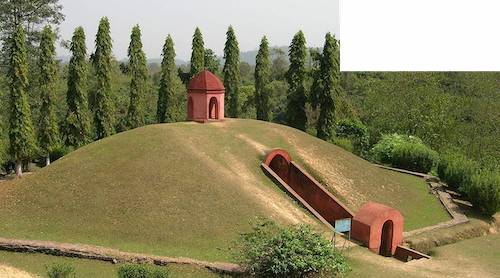Assam: Moidam
This is a collection of articles archived for the excellence of their content. |
2023: Nominated for UNESCO heritage sites
January 24, 2023: The Times of India

From: January 24, 2023: The Times of India
Assam Chief Minister Himanta Biswa Sarma announced that the central government has decided to put forth the name of Assam’s Charaideo moidams burial sites for addition to United Nations Educational, Scientific and Cultural Organization’s (UNESCO) World Heritage Sites list.
He tweeted, “If selected, 90 royal burials at Charaideo will be the only cultural heritage site in the North East to get the coveted status. Assam making it to the nomination among 52 sites in India really reflects our Adarniya PM’s love & respect for the rich cultural heritage of Assam & NE.”
The Charaideo moidams are royal burial sites of the Ahom dynasty, which ruled over much of Assam and the North East from 1228 to 1826 AD. Located around 30 km from Sivasagar town in eastern Assam, even today, the tumuli in Charaideo are considered sacrosanct by many locals.
What are moidams?
A moidam is a tumulus – a mound of earth raised over a grave – of Ahom royalty and aristocracy. While Charaideo exclusively contains moidams of Ahom royals, other moidams of aristocrats and chiefs can be found scattered across Eastern Assam, in the region between the towns of Jorhat and Dibrugarh.
A typical moidam at Charaideo contains one or more chambers in a vault. On top of these is a hemispherical earthen mound, rising high above the ground, covered in grass. On top of this mound, there is a pavilion, known as the chow chali. A low octagonal wall surrounds the mound with one entrance.
Ahom kings and queens were buried inside these moidams. Unlike Hindus who cremate their dead, the predominant funerary method of the Ahoms, originating from the Tai people, was the burial. The height of a moidam is typically indicative of the power and stature of the person buried inside. However, except for those of Gadhadhar Singha and Rudra Singha, most moidams remain unidentified.
Inside the chambers of the moidam, the dead king would be buried along with items he needed for the “afterlife”, as well as servants, horses, livestock and even their wives. It is the similarity of the Ahom burial rites with that of the ancient Egyptians that give Charaideo moidams the moniker of “Pyramids of Assam.”
Why was Charaideo important?
The word Charaideo has been derived from three Tai Ahom words, Che-Rai-Doi. “Che” means city or town, “Rai” means “to shine” and “Doi” means hill. In short, Charaideo means, “a shining town situated on a hilltop.”
While the Ahoms shifted capitals multiple times over their 600-year history, Charaideo is considered to be their first capital city established in 1253 AD by king Sukaphaa. Throughout the Ahom rule, it remained a symbolic and ritual centre of power, due to its salience in the dynasty’s founding. After Sukaphaa was laid to rest in Charaideo in 1856, subsequent royals also chose it as their own resting place.
Today, these moidams are major tourist attractions. While there are over 150 moidams in the region, only 30 are protected by the Archaeological Survey of India with many in a state of disrepair.
According to the dossier on the Charaideo Moidams, such burial sites have been seen in across East and Southeast Asia but the “cluster of moidams in Charaideo distinguishes itself in scale, concentration and being located in the most sacred land of the Tai-Ahoms”.
Who were the Ahoms and what is their present-day relevance?
The Ahoms were one of India’s longest-reigning ruling dynasties. At their peak, their kingdom stretched from modern-day Bangladesh to deep inside Burma. Known to be able administrators and valiant warriors, the Ahom dynasty has enduring cultural appeal in Assam.
Historian Arup Kumar Dutta, the author of The Ahoms, told The Indian Express in 2021 that the Ahoms represented a time when the “Assamese race was united and able to fight an alien, formidable force such as the Mughals”. This has become even more relevant with BJP’s nationalist rhetoric growing stronger.
Last year, Ahom general and folk hero Lachit Borphukan’s 400th birth anniversary was celebrated with pomp in New Delhi, from November 23 to 25. On the occasion, Prime Minister Narendra Modi tweeted, “Greetings on Lachit Diwas. This Lachit Diwas is special because we mark the 400th birth anniversary of the great Lachit Borphukan. He epitomised unparalleled courage. He placed the well-being of people above everything else and was a just as well as visionary leader.”
Today, despite originating from South Chinese ruling dynasties, Ahoms are invoked as local Indian rulers who left behind a strong legacy.